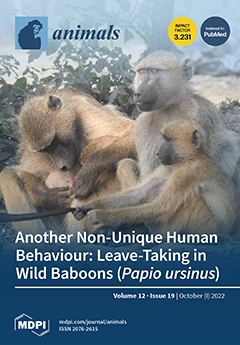During the processing of compound feed for broilers, several changes occur that affect the physical and probably the nutritional properties of pellets, influencing animal performance. The effects of mill type, particle size (PS) and expander conditioning prior to pelleting (E + P) were combined to generate pellets. A 2 × 3 × 2 factorial arrangement was designed with two mill types (a hammer mill (HM) or roller mill (RM)), three PSs (0.8, 1.2 or 1.6 mm) and two E + Ps (with or without expander processing prior to pelleting), with six replications of 12 unsexed Ross 308 broilers each. All the processing lines reduced the PS from mash to finished pellets via secondary grinding, by 2.35 times on average. However, RM grinding required less electric power (
p < 0.001). The intended PS (0.8, 1.2 or 1.6 mm) did not affect this energy consumption. E + P and the PS interacted for the pellet durability index (PDI) (
p = 0.006). The worst PDI in the pellets was observed when a PS of 1.6 mm without E + P was used. Only E + P positively affected starch (
p < 0.001) and amino acids’ ileal apparent digestibility (
p < 0.01). Organic matter (OM) (
p = 0.02) and fat (
p < 0.001) digestibility, as well as AME
N (
p = 0.005) content, were influenced by the PS (main effect), whereas E + P and mill type interacted with these values (
p < 0.005). Lower OM digestibility and AME
N content were observed when RM without E + P was used (
p = 0.001). The feed conversion ratio (FCR) was enhanced and feed intake (FI) was improved with E + P. The combination of the RM mill, a 1.6 mm mean PS, and E + P improved FCR (three-way interaction,
p = 0.019)), showing that for a higher PS, E + P is necessary for animal performance. Carcass yield was, on average, 80.1%. No effects on commercial cuts (breast, legs and wings) were observed. In contrast, abdominal fat was affected by mill type * PS (
p = 0.012) and E + P * PS (
p = 0.048) in a two-way interaction. The highest abdominal fat indicated an imbalance in the amino acid (AA)-to-AME
N ratio. Coarse PS promoted heavier gizzards (
p = 0.02) but E + P tended to reduce them (
p = 0.057). The processing steps improved pellet quality and feed efficiency associated with RM, coarse PS and E + P, highlighting the positive effects of E + P on abdominal fat and AME
N content, which should be adjusted to AA or reduced at formulation. However, these results are for an experimental processing plant and may not necessarily apply to larger plants, so the use of these data and methods should be considered as guidelines for replication at production sites.
Full article






